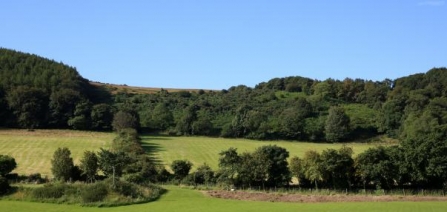
Crossags Coppice (c) GMW

Crossags Coppice (c) GMW
Crossags Coppice is a five-acre field of bracken and gorse that has already been planted in 2015 and 2016 by Manx Wildlife Trust with over 1000 native hazel, oak and birch. Work has been carried out prior to the purchase by kind permission of the previous landowner.
It is an area of great natural beauty for its population of over one million bluebells that flower every May. This has been an inspiration for conservation work in Claughbane Plantation to start to naturally spread the bluebell populations over nearly a mile of wooded hillside.
Crossags Coppice will be managed as a traditional coppice woodland, just as Manx woodlands were managed until the 20th century. Management will be to promote the bluebell populations, encourage bird nesting, bat feeding and butterfly populations. It will also allow for more and better access to Ramsey’s wildlife for people through its path network.
Andree Dubbeldam, MWT Project Officer said: “We will manage this reserve as hazel coppice woodland where trees are cut down on a regular basis to harvest poles. This type of management is especially good for wildflowers, butterflies, bees and songbirds. While most woodlands take over 100 years to reach maturity and gain full biodiversity, hazel coppice woodland will be a great habitat in as little as six years. The paths in the woodland will allow anyone to visit the reserve”
Crossags is also a strategic purchase as a part of our Ramsey Forest Project, as it will close the last gap that connects all the ancient woodlands around Ramsey (Ballure Glen, Elfin Glen and Glion ny Grawe) and will allow biodiversity to spread and thrive.
The Ramsey Forest Project is a 30-year plan to create a new forest around Ramsey, the aim is to increase woodland cover from 20% to 30% covering an area of 20 square kilometres. Native woodland needs to increase from fivefold from 100 acres currently by planting new woodland, converting conifer plantations and letting nature develop woodland naturally on rough land. This is a great opportunity to lock away carbon, engage the community, connect people with nature and help us stay healthy.
“It’s a great example of wildlife connectivity, with the site joining important woodlands up. It also helps show the benefits of a wilder future, with landscapes like this increasing wildlife, helping us stay healthy getting outdoors and connecting with nature, and its all part of how our natural environment can help the climate emergency.”
Tim Graham, CEO of Manx Wildlife Trust, continued, “It’s all part of some great work that has really energised the community with hundreds of volunteers helping out, including Ramsey Rotary Club who planted native trees and we work closely with local schools.”